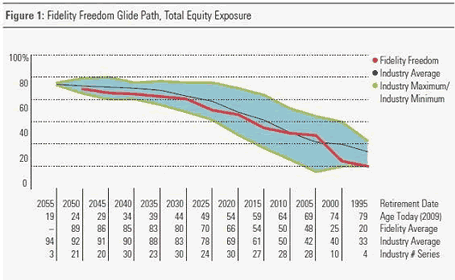Inside this recent Morningstar article about the pros and cons of Fidelity’s Freedom Funds was an interesting chart that incorporated data from all of the target-date retirement funds. These funds were getting really popular as a set-and-forget type of investment, until many people found found out in 2009 that their risk tolerance didn’t necessarily mesh with the what the investment company thought it would be.
A fund’s “glide path” is how they shift their asset allocation to be more conservative as time goes on and they near the retirement target date. A very general way to measure this is to take the percentage of the fund invested in equities (stocks).

As you can see, there can be a significant variation between the industry maximums and minimums for each year. Fidelity’s fund tend to be near the average, perhaps a tiny bit below most of the time. I looked at Vanguard’s funds, and they are also very close to the average. TRP’s glide path is almost always above the average, but not by more than 5-10%.
You can see the specific glide path chart of other funds with a Morningstar Premium membership (see below). However, you can always use the free Instant X-Ray tool with the ticker symbols from your own series of funds and plot it yourself. How does yours compare?
This is just one component of what you should be looking at when choosing between fund choices, with other examples being cost (expense ratio?), equity breakdown (international exposure?), and bond breakdown (quality?). Of course, some of us are just stuck with one choice in our 401k/403b plans.
List of the 20 most popular target date funds:
* AllianceBernstein Retirement Strategies Target-Date Fund Series
* American Century LIVESTRONG Target-Date Fund Series
* American Funds Target Date Retirement Target-Date Fund Series
* DWS LifeCompass Target-Date Fund Series
* Fidelity Advisor Freedom Target-Date Fund Series
* Fidelity Freedom Target-Date Fund Series
* ING Solution Target-Date Fund Series
* John Hancock Lifecycle Target-Date Fund Series
* JPMorgan SmartRetirement Target-Date Fund Series
* MassMutual Select Destination Rtmt Target-Date Fund Series
* MFS Lifetime Target-Date Fund Series
* Oppenheimer Transition Target-Date Fund Series
* Principal LifeTime Series Target-Date Fund Series
* Putnam RetirementReady Target-Date Fund Series
* Schwab Target Target-Date Fund Series
* TIAA-CREF Lifecycle Target-Date Fund Series
* T. Rowe Price Retirement Target-Date Fund Series
* Vanguard Target Retirement Target-Date Fund Series
* Vantagepoint Milestone Target-Date Fund Series
* Wells Fargo Advantage DJ Target-Date Fund Series
 The Best Credit Card Bonus Offers – October 2024
The Best Credit Card Bonus Offers – October 2024 Big List of Free Stocks from Brokerage Apps
Big List of Free Stocks from Brokerage Apps Best Interest Rates on Cash - October 2024
Best Interest Rates on Cash - October 2024 Free Credit Scores x 3 + Free Credit Monitoring
Free Credit Scores x 3 + Free Credit Monitoring Best No Fee 0% APR Balance Transfer Offers
Best No Fee 0% APR Balance Transfer Offers Little-Known Cellular Data Plans That Can Save Big Money
Little-Known Cellular Data Plans That Can Save Big Money How To Haggle Your Cable or Direct TV Bill
How To Haggle Your Cable or Direct TV Bill Big List of Free Consumer Data Reports (Credit, Rent, Work)
Big List of Free Consumer Data Reports (Credit, Rent, Work)
I would love to hear more on Jonathan’s opinions on target date funds.
I use the vanguard VTIVX 2045 fund. Maxing out this yr for the 2nd yr in a row.
The best way to choose a target retirement fund is to figure out in advance what your desired asset allocation is based on your own situation (time horizon, portfolio size, tolerance for risk), then pick the one that most closely matches. Most people want less risk than they would get by just blindly choosing a fund based on the target date. However, if you don’t know how to choose an asset allocation, just blindly picking one will leave you better off than you would be if you did anything else. (Like the worst thing you could do: hire a financial advisor.)
I second Marie’s comment on the desire to hear more from Jonathan about target date funds.
Like Jonathan, I’m an asset class junkie and happily using a portfolio of various passive funds that I rebalance from time to time. But I’m also helping my girlfriend plan for her retirement, and she does not share my interest in investing. I started her off in Vanguard’s Star fund, but now that her holdings are above the minimum for other funds I’d like to put her into a target retirement fund instead. Any information on these funds would be welcome.
Kiplinger’s January issue has a great article on Target date funds, pg 42. The most interesting thing I found was that it shows vastly different glide paths for three funds with the same target date. The three funds were Oppenheimer Transition 250, T.Rowe Prince Retirement 2050, and Wells Fargo Advantage Dow Jone Target 2050. All start and end at the same time…but the stock/bond allocations are vastly different…so beware of what you buy…maybe Jonathan can pull the glide path graphic from the online version if it is posted there. worth a look.
A similar look at glide paths using bond and cash %, as well as equity %’s.
http://www.mariposacap.com/blog/2009/11/04/glide-path-a-target-date-funds-secret-sauce/